Eminent Domain & The Supremes — STOP! in the name of gov…
June 27th, 2005
I’m astounded of the number of people who are talking about last week’s Supreme Court eminent domain decision in Kelo v. New London. Can it be that people are finally catching on — that erosion of our constitutional rights is being noticed? In alpha order, here’s Betsy Buckheit’s thoughts, Buckheit #2, and Bruce Moreland, from the Northfield area.
Here’s the decision, Kelo, et al. v. City of New London, et al. It’s long but well worth the read.
The glimmer that jumped out at me is set out in today’s STrib too:
The court’s opinion basically invited state legislatures across the county to restrict the broad power of eminent domain that exists under current law.
Here’s what Ralph Nader had to say about it, thanks to Barbara Vaile for sending it around, it’s posted on U.S. Newswire:
Statement of Ralph Nader on Supreme Court Eminent Domain
6/23/2005 6:53:00 PM
To: National Desk
Contact: Ralph Nader, 202-387-8030
WASHINGTON, June 23 /U.S. Newswire/ — Following is a statement of Ralph Nader on the Supreme Court eminent domain:
The U.S. Supreme Court’s decision in Kelo v City of New London mocks common sense, tarnishes constitutional law and is an affront to fundamental fairness.
The Fifth Amendment to the United States Constitution permits government to seize private property for a “public use,” such as a highway, railroad, or military facility, provided it gives the owner “just compensation.” Many state constitutions have similar provisions. But in modern times it has become common for the government, usually at the state or local level, to seize property and transfer it to another private party rather than maintaining it for public use.
Hundreds of abuses of eminent domain have occurred during the last few decades, with municipalities playing reverse Robin Hood? taking from ordinary citizens and giving to powerful individual developers or corporations. In many cases, the alleged public benefit is a transparent cover for what amounts to legalized theft.
With today’s decision, the Court has abdicated its role as guardian of the Constitution and individual rights. This decision authorizes courts across the country to allow self- defining misuses of “public use” and “public benefit” requirements. State courts, however, remain free to impose more reasonable restraints on government taking of individual property.
For a more detailed discussion of this topic see: Ralph Nader & Alan Hirsch, “Making Eminent Domain Humane,” 49 Villanova Law Review 207 (2004).
For More information contact: Ralph Nader 202-387-8030
Burton Hanson had a few things to say about this too today.
Check Minnesota’s Walser July, 2001 appellate case, and April, 2002 MN Supreme Court case, where land was taken in Richfield for Best Buy, at 494 and Penn (I can remember when that was a farm!). Last time I drove by, there as a big “for lease” sign… hmmmmm…
Who cares about eminent domain? Look at that Mesaba bill, lines 41.8-41.14, where a private company was granted eminent domain to build a power plant we don’t need, where a legislative mandate was required for a power purchase agreement because there’s no market for electricity. Eminent domain is just one of the unprecedented perks for this for-profit corporation that is NOT a public service corporation. Just who is benefitting? Where’s the public purpose?
Here’s the Mesaba language:
40.12 ARTICLE 4
40.13 INNOVATIVE ENERGY PROJECT
40.14 Section 1. [INNOVATIVE ENERGY PROJECT.]
40.15 Subdivision 1. [DEFINITION.] For the purposes of this
40.16 section, the term “innovative energy project” means a proposed
40.17 energy generation facility or group of facilities which may be
40.18 located on up to three sites:
40.19 (1) that makes use of an innovative generation technology
40.20 utilizing coal as a primary fuel in a highly efficient
40.21 combined-cycle configuration with significantly reduced sulfur
40.22 dioxide, nitrogen oxide, particulate, and mercury emissions from
40.23 those of traditional technologies;
40.24 (2) that the project developer or owner certifies is a
40.25 project capable of offering a long-term supply contract at a
40.26 hedged, predictable cost; and
40.27 (3) that is designated by the commissioner of the iron
40.28 range resources and rehabilitation board as a project that is
40.29 located in the taconite tax relief area on a site that has
40.30 substantial real property with adequate infrastructure to
40.31 support new or expanded development and that has received prior
40.32 financial and other support from the board.
40.33 Subd. 2. [REGULATORY INCENTIVES.] (a) An innovative energy
40.34 project:
40.35 (1) is exempted from the requirements for a certificate of
40.36 need under Minnesota Statutes, section 216B.243, for the
41.1 generation facilities, and transmission infrastructure
41.2 associated with the generation facilities, but is subject to all
41.3 applicable environmental review and permitting procedures of
41.4 Minnesota Statutes, sections 116C.51 to 116C.69;
41.5 (2) once permitted and constructed, is eligible to increase
41.6 the capacity of the associated transmission facilities without
41.7 additional state review upon filing notice with the commission;
41.8 (3) has the power of eminent domain, which shall be limited
41.9 to the sites and routes approved by the environmental quality
41.10 board for the project facilities. The project shall be
41.11 considered a utility as defined in Minnesota Statutes, section
41.12 116C.52, subdivision 10, for the limited purpose of Minnesota
41.13 Statutes, section 116C.63. The project shall report any intent
41.14 to exercise eminent domain authority to the board;
41.15 (4) shall qualify as a “clean energy technology” as defined
41.16 in section 216B.1693;
41.17 (5) shall, prior to the approval by the commission of any
41.18 arrangement to build or expand a fossil-fuel-fired generation
41.19 facility, or to enter into an agreement to purchase capacity or
41.20 energy from such a facility for a term exceeding five years, be
41.21 considered as a supply option for the generation facility, and
41.22 the commission shall ensure such consideration and take any
41.23 action with respect to such supply proposal that it deems to be
41.24 in the best interest of ratepayers;
41.25 (6) shall make a good faith effort to secure funding from
41.26 the United States Department of Energy and the United States
41.27 Department of Agriculture to conduct a demonstration project at
41.28 the facility for either geologic or terrestrial carbon
41.29 sequestration projects to achieve reductions in facility
41.30 emissions or carbon dioxide;
41.31 (7) shall be entitled to enter into a contract with a
41.32 public utility that owns a nuclear generation facility in the
41.33 state to provide 450 megawatts of baseload capacity and energy
41.34 under a long-term contract, subject to the approval of the terms
41.35 and conditions of the contract by the commission. The
41.36 commission may approve, disapprove, amend, or modify the
42.1 contract in making its public interest determination, taking
42.2 into consideration the project’s economic development benefits
42.3 to the state; the use of abundant domestic fuel sources; the
42.4 stability of the price of the output from the project; the
42.5 project’s potential to contribute to a transition to hydrogen as
42.6 a fuel resource; and the emission reductions achieved compared
42.7 to other solid fuel baseload technologies; and
42.8 (8) shall be eligible for a grant from the renewable
42.9 development account, subject to the approval of the entity
42.10 administering that account, of $2,000,000 a year for five years
42.11 for development and engineering costs, including those costs
42.12 related to mercury removal technology; thermal efficiency
42.13 optimization and emission minimization; environmental impact
42.14 statement preparation and licensing; development of hydrogen
42.15 production capabilities; and fuel cell development and
42.16 utilization.
42.17 (b) This subdivision does not apply to nor affect a
42.18 proposal to add utility-owned resources that is pending on the
42.19 date of enactment of this act before the public utilities
42.20 commission or to competitive bid solicitations to provide
42.21 capacity or energy that is scheduled to be online by December
42.22 31, 2006.
42.23 Sec. 2. [EFFECTIVE DATE.]
42.24 This article is effective the day following final enactment.
From the STrib today, New Ruling Means No Property Is Safe:
The court’s opinion basically invited state legislatures across the county to restrict the broad power of eminent domain that exists under current law.
The Minnesota Legislature should give citizens the right to challenge a project’s “public purpose” in court; it should set up a system to give citizens back their attorneys’ fees if their challenge is successful; and private property owners should be adequately compensated for these takings if they occur.
Minnesotans deserve protection from government run amok. The Legislature should pass eminent domain reform now.
Landowners are overdue for a change in compensation that addresses the massive profits that the recipients reap as a result of taking land. Sen. Vickerman has been working on it, and here’s SF 462, a work in progress. Here’s something to talk about while you’re “sitting in.”
I’ve got some specifics thoughts on this, but of course my notes are at home, so later… and sorry about that title, but I’ve still got last week’s Al Sicherman’s “it’s waning all over the world” going through my brain… touche!
Gunflint Tavern in Grand Marais & horses in Florida
June 27th, 2005
The internet is amazing. I’d done a quick search for some folks from St. Lawrence Band, and two of the MIA’s were a friend and her sister, and a 30 second search turned them up.
Sue runs a restaurant, and damned if I didn’t park in the spot this photo was taken of her Gunflint Tavern, in Grand Marais. Check that pink ’63 Mopar! I was there searching for breakfast about a month ago as part of my CLE tour. If you’re up in Grand Marais, be sure to stop in! The Gunflint Tavern is at 111 Wisconsin St., Grand Marais. Phone is (218) 387-1563. But it’s easy to find, just follow your nose to the real food! From the south on 61, go into town and take a right and go to the water, and it’s right across from where the boats are anchored.
Sandra runs C&S Horse Boarding in Florida, what heaven!
Wind on the Rails
June 26th, 2005
Another train with wind turbines came through Red Wing on it’s way up to a big wind development in Canada. Ron Barber, of Stewartville, chased the train up to Newport and is sending photos that I’ll post as soon as I get them. In the meantime, here’re a few from Christopher Mueller, of Cass Lake, Minnesota, taken on June 25, 2005, in Mahnomen and between Mahnomen and Brooks:
This one was taken in Mahnomen.
View down the length of the train.
Close-up of Vestas rotor.
Scenic nacelles – ought to be on a calendar!
Blades
Lots of rotors
Blade profile – another wind calendar photo
Thanks to Ron and Chris for catching the train!
I-35 DEVELOPMENT – Northfield League of Women Voters Discussion
June 26th, 2005
Kiffi Summa stopped by on Friday and she told me that tomorrow is the first of the “4th Monday” discussion series, and this month’s topic is the I-35 and Highway 19/Co.Rd. 1 Development proposals.
This is from the LWV site, and I see Griff posted it too:
Proposed I-35/Hwy 19 Development Area to Be First 4th Monday Discussion Topic
The Northfield League of Women Voters is beginning a new public meeting series called 4th Mondays. On the fourth Monday of each month, at 7 P.M., beginning June 27th, at the Northfield Public Library, there will be a “lightly moderated” community discussion of a current issue or topic.
The topic for the June 27th session will be the proposed commercial development corridor along I-35, south of Hwy. 19.
Each month¹s topic will be announced the week before the meeting in the Northfield News and on the Library bulletin board. The League¹s goal is to share information, gather input, and encourage civic participation. All the public is welcome. If you have questions, call (507) 663-6097.
——————————————————
Here’s what Rice County is proposing, they call it “Economic Development”, their Master Plan:
North Section
South Section
Infrastructure
You might want to call your County Commissioner to make sure they’re there to hear the discussion! Here’s their contact info.
TRANSMISSION FOR DUMMIES #2: IT’S NOT FOR WIND!
June 25th, 2005

New coal is being built
Transmission ?for wind? from Buffalo Ridge on the 345kV line is at best only 11% of its capacity
Wind energy from Buff Ridge to the metro takes the scenic route through Manitoba and much gets lost along the way!
Remember Michael Noble’s dream as set out in the Sierra Club newsletter?
Instead of planning transmission to serve new coal plants, let’s begin discussing a project that combines the following: renewable energy from wind farms and bio-gas plants, a new high-capacity border-to-border powerline across southern Minnesota and northern Iowa, and as many locally owned energy projects as can be organized along the route. Let’s dub this project Next Generation, a $5 billion project completed within five years. What if this Next Generation project offset the need for two or more coal plants? What if this Next Generation project brought wealth and opportunity to 20+ communities? The stage is already being set.
The stage is indeed set, with great acting, scripted lines on cue. Who does a new high-capacity border-to-border powerline across southern Minnesota and northern Iowa serve? It’s not binary, as we say in transmission, it isn’t either coal or wind, it’s whatever generation is there in the MISO queue waiting for interconnection and can connect. Wind can’t connect to the 354kV line, it’s cost prohibitive and a technical nightmare, and that’s why a web of 34.5kV collector lines is being woven into the lower voltage lines. What type of generation is in large volumes to utilize 345kV lines and is waiting for interconnection to transmission? COAL! And lots of it!
NEW COAL IS BEING BUILT
Here’s the list of proposed coal plants and wind projects listed in the Xcel?s 2001 SW Minnesota study, p. 29, the ones in bold are ones on the way, moving forward to construction:
Entity Approx. MW
GRE (ND Lignite) 500
MDU/Westmoreland (ND Lignite) 500
WAPA Wind (North Dakota) 300
WAPA Wind (South Dakota) 300
WAPA Dakotas wind/Thermal not yet determined, likely thousands of MW
OTP Big Stone (coal) 600 (federal EIS hearing last week)
Unidentified IPP/Study by MidAmerican (SW Iowa) 700-875
SMMPA/Redwood Falls Municipal (diesel) 7
MidAmerican (coal?Council Bluffs, Iowa) 790 (under construction)
MidAmerican (gas?Desmoines) 540
MRES (gas?Watertown, SD) 150
WAPA/Basin Electric NDEX increase 100
Unidentified IPP/study by Alliant (Nobles Co) 340
And don’t forget about that coal plant just south of Adams on the Iowa side of the border that I hear is on again, off again, on again…
According to Xcel’s study, there’s 2,390 MW in the area specifically identified as coal that Xcel anticipates, 1,390MW in the permitting process, 790MW Mid-American plant of that under construction right now. From Xcel’s list, what’s being built and coming on line is coal.
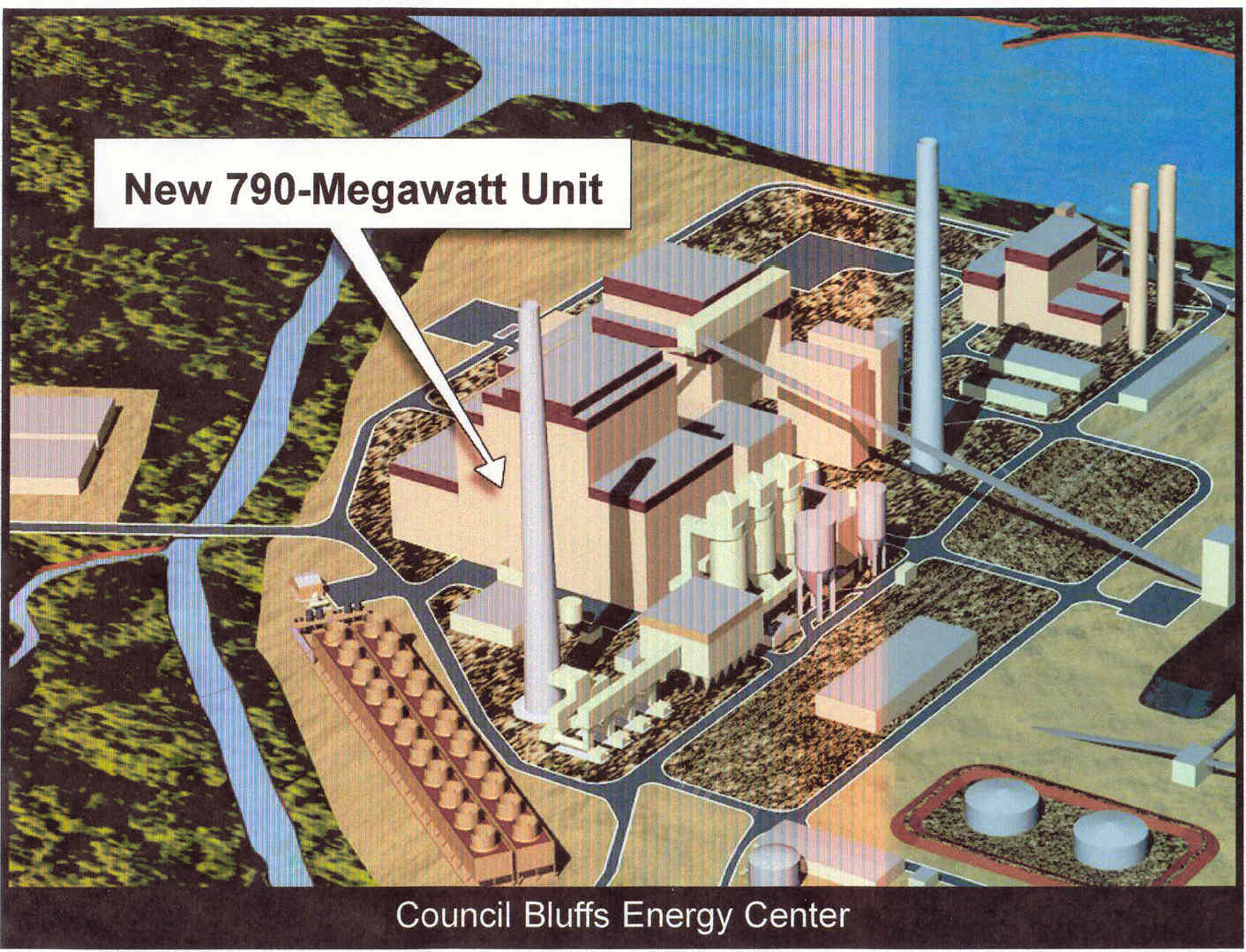
Yet the resulting major transmission line from this SW Minnesota study was the 345kV line, from Sioux Falls (Split Rock Substation) to Lakefield Junction, and a 161kV line extending east from Lakefield Junction to Fox Lake. It’s now permitted by the PUC and EQB and ready to build, look at the maps to see the eastward creep of transmission…
Split Rock to Lakefield Junction 345kv transmission line
— Map – western half
— Map – eastern halfLakefield Jct. to Fox Lake 161kV transmission line
— Map
TRANSMISSION “FOR WIND” FROM BUFFALO RIDGE ON THE 345kV LINE IS AT BEST ONLY 11% OF ITS CAPACITY
Let?s look at the easier part, what this line doesn?t do. Although some say the line is necessary for wind, it doesn?t serve wind. That is demonstrated in the powerflows, Xcel?s Rick Gonzalez testified about this under my cross-examination during the SW Minnesota 345kV proceeding. The 345kV line goes from Sioux Falls (Split Rock substation) to Lakefield Junction, and there is only one entry point in between where wind energy can get on the 345kV line, at the Nobles substation.
The capacity of the line is 2068-2085MVA. Here’s the chart showing the maximum capacity of a bundled 345kV 954kcmil ACSS line. View image
Xcel?s powerflows show the 345kV line, the Split Rock, Nobles and Lakefield Junction substations, and the power going into the 345kV line at the Nobles Substation. Here they are, see for yourself.
First, there are two powerflow charts, because it was uncertain whether the wind development would be primarily in the south part of Buffalo Ridge or in both south and north. Xcel looked at both, the 100/0 representing all development in the south, and the 50/50 representing a split between south and north. What you will see in these powerflows is that in either the 100/0 scenario (100% of wind to south, none in north) or in the 50/50 scenario (development split between south and north), no more than 15% of the capacity of that line is used by wind off of Buffalo Ridge. In the 100/0 scenario, the rosiest of pictures, 302MW of energy comes off of Buffalo Ridge into the 345kV line. (upload powerflow 100/0). That?s 302 of the 2085 capacity. But the generation development is split between north and south, the 50/50 scenario is reality, so it’s a 213 to 2085 ratio of energy from Buffalo Ridge to the capacity of the line, 213/2085.
Here?s the 100/0 powerflow, below, the scenario that provides more wind energy outlet onto the 345kV line, but that is not representative of the location of wind development, therefore not valid. The substations are highlighted, and the one in the middle is Nobles. The ?302? at Nobles represents the MW coming off of Buffalo Ridge into the 345kV line that has a capacity of 2085MVA. Click here for a full size 100/0 that’s below.View image”
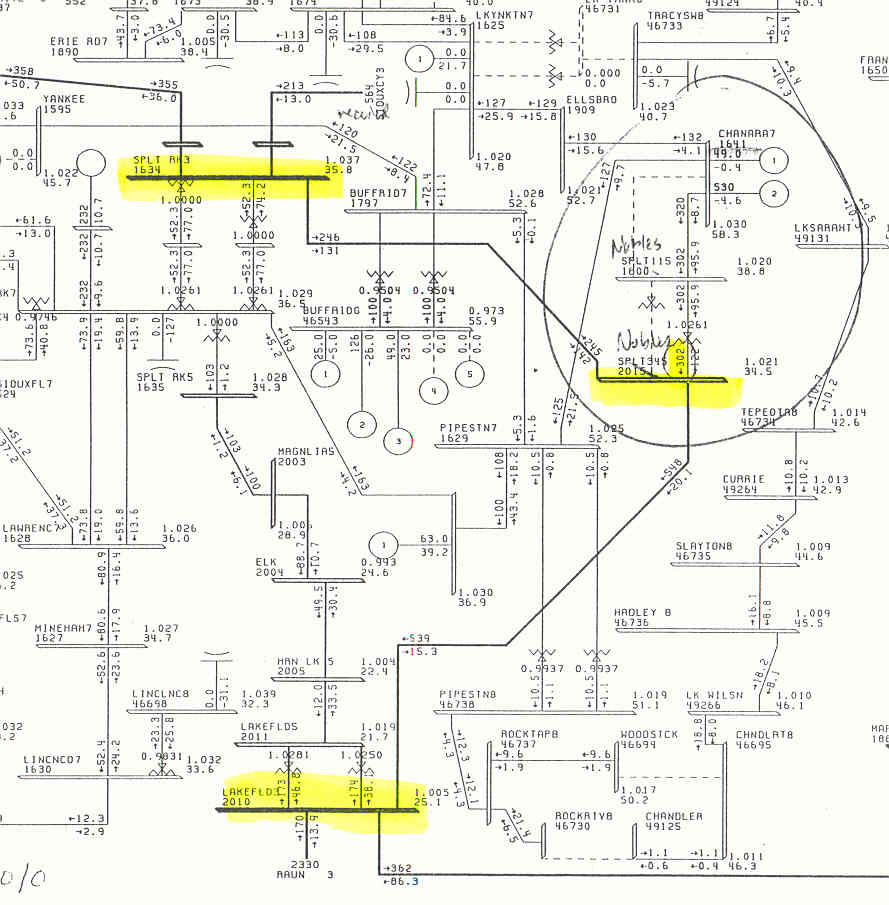
In the 50/50 scenario, below, only 213MW of energy comes off of Buffalo Ridge into the 345kV line, 213 out of 2085MVA. Click here for the full size version of chart below. View image
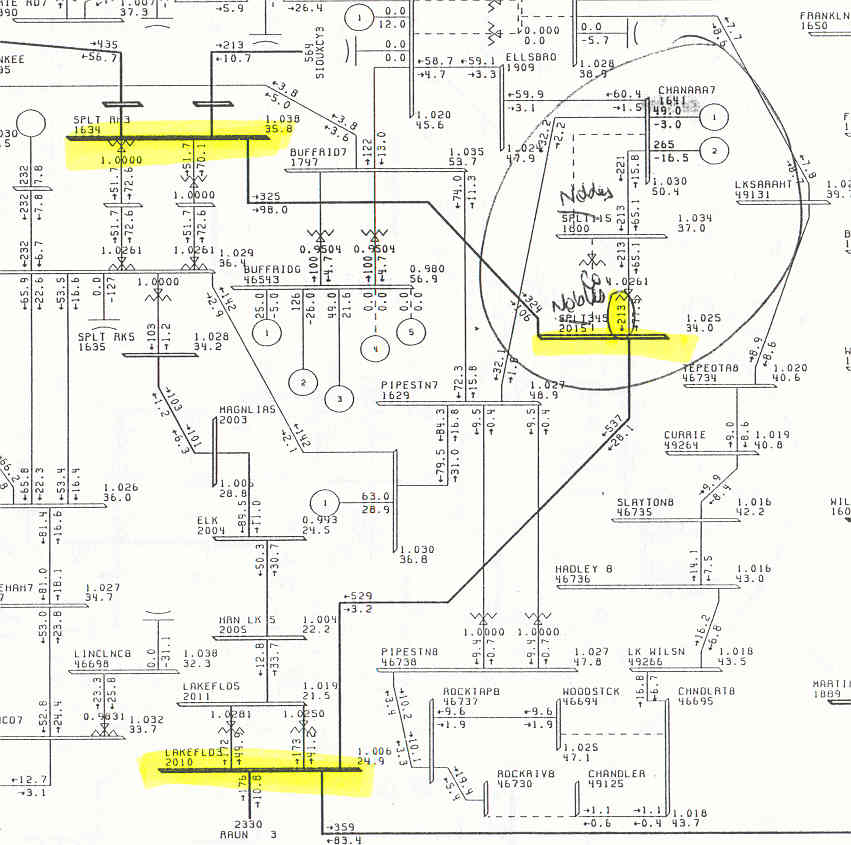
The 345kV line recently granted a site certificate by the EQB is not even remotely for “Buffalo Ridge wind” ? Buffalo Ridge wind is only a very small part. Then what?s it for? Well, we know there?s plenty of coal coming on line. Transmission capacity goes to those who are up and running with reservations for its use.
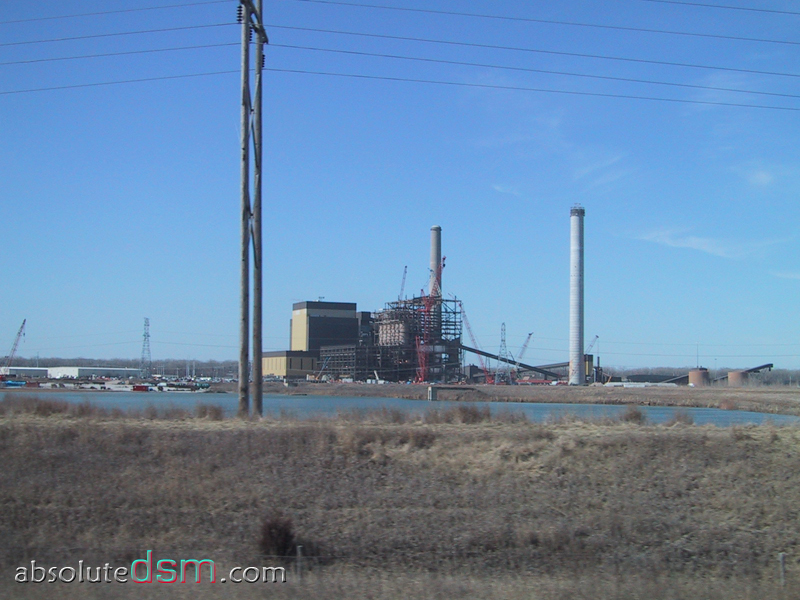
Deadline for public comments on EIS scoping for the Big Stone power plant is midnight, July 27. Send input to NEPA Document Manager, Big Stone II EIS (A7400), Western Area Power Administration, P.O. Box 281213, Lakewood, CO 80228-8213.
The Big Stone II is expected to be on line in 2011.
WIND ENERGY FROM BUFF RIDGE TO THE METRO TAKES THE SCENIC ROUTE THROUGH MANITOBA AND MUCH GETS LOST ALONG THE WAY!
*** A discovery in the ongoing Buffalo Ridge Ongoing Incremental Outlet Study, reflected in the modeling, is that the Buffalo Ridge wind energy, because there is not sufficient outlet capacity from Buffalo Ridge, is taking the scenic route to the metro area via Dorsey, Manitoba, then the Forbes substation in Minnesota, down the 500kV line to the Chisago County substation and then, after a circuitous 800 or so mile trip, to the metro area. Here’s a piece of the MAPP map, which shows only transmission lines 115kV and above and substations:
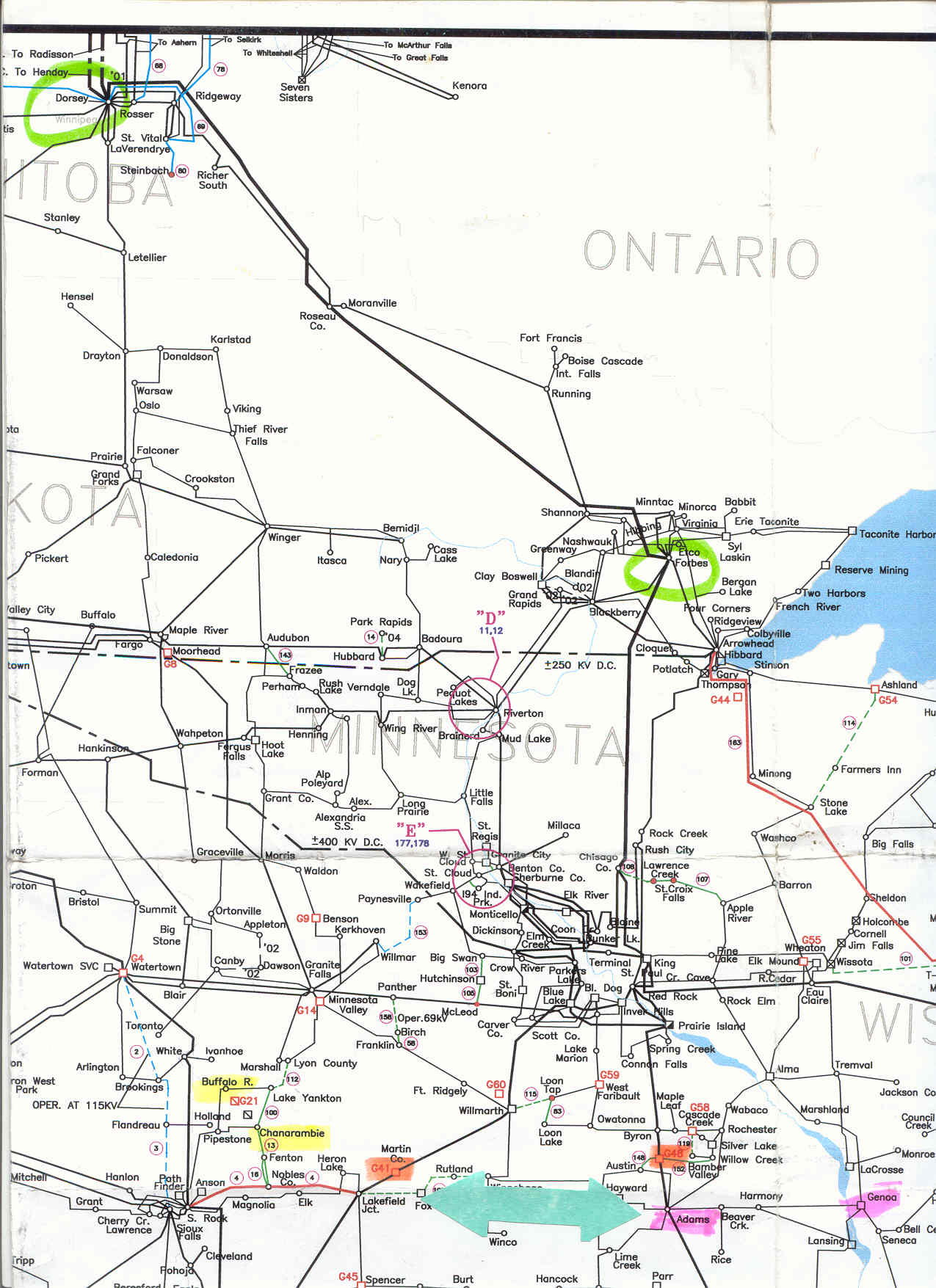
This is the scenic route that some Buffalo Ridge wind energy is taking. It goes from the yellow highlighted substations in the lower left, that’s the Buffalo Ridge and Chanarambie subs on Buffalo Ridge, from there up to the green circle in the far upper left, the Dorsey sub, then down to the right to the other green circle, the Forbes sub, and then down to the metro. How’s that for the long way around?
Potential ways of dealing with this including adding capacitors in Manitoba, increasing the limits on the line so that the increase won’t put it in the danger zone, or, lastly, adding/extending the 345kV line eastward from Buffalo Ridge.
Keep in mind that all of these scenarios and numbers are computer modeling, which is dependent on the base case, what assumptions are made, and this study is more public that the 345kV information, and I think it would be easier to get the specific modeling assumptions than it was in the earlier proceeding.
Line Losses – more on this in a future TRANSMISSION FOR DUMMIES, but in a nutshell, line losses are the energy that is lost by transmitting electricity over lines over long distances, really, over any distance, but the longer the distance, the greater the line loss. For the purposes of the SW Minnesota proceeding, a 30% line loss was assumed (p. 20). Here’s the question. If line losses from Buffalo Ridge to load were presumed to be 30%, what are the line losses associated with a scenic trip through Manitoba, over to Forbes, about 3 times the distance anticipated?
Let’s do some abstract thinking here. The Renewable Energy Standard (HF35) was a mandated stepped increase to 20% generation by renewable sources by 2020. A commonly held conservation goal is 20%. Line loss for Buffalo Ridge wind generation is presumed to be 30%. Wind generation has an inherently low capacity factor because the wind is varialbe, and Waverly Light & Power’s NEG Micon wind turbine, a relatively high producer, has a 36% capacity factor.
Thought for the day: Couldn’t we integrate wind energy, which has low capacity factor, into the mix more effectively by conserving renewable energy by siting it close to load to eliminate or reduce line losses? 30% line losses of a 36% capacity factor generating source doesn’t leave much for use.
FYI, here’s the prefiled testimony, much of it about calculation of line losses, of my expert witness, Dr. Art Hughes, Ph.D.
Xcel SW Minnesota transmission proceedings documents
Here’s the EQB Docket for the 345kV line from Sioux Falls (Split Rock)to Lakefield Jct. and a 115kV line in Xcel’s SW Minnesota plan.
Here’s the EQB Docket for the 161kV line from Lakefield Jct. to Fox Lake in Xcel’s SW Minnesota Plan.
Here’s the PUC docket on Xcel’s SW Minnesota transmission lines. This is the ME3 website for SW Transmission, so scroll down to the PUC section.
Next up – TRANSMISSION FOR DUMMIES #3, which will include the history of this 345kV line across southern Minnesota, from the WRAO study in 1998, the Lignite Vision 21 study in 2001, ATC’s 2004 (and earlier versions too) 10 Year Plan, MTEP 03, and CapX2020, all working toward the same goal. And after that, everything you ever wanted to know about line losses.